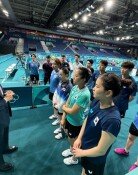Corporate City Tangjeong Drawing Mixed Reviews
Corporate City Tangjeong Drawing Mixed Reviews
Posted November. 17, 2009 08:41,
Tangjeong in South Chungcheong Province is a successful example of a corporate city in Korea. The city is playing a critical role in revitalizing the regional economy by generating jobs.
Tangjeong, however, is also breeding wild geese fathers, or Korean men who live away from their families for the sake of their childrens education, and long distance commuters in the wake of opposition by civic groups to the citys creation. This has led to a smaller version of the city.
○ Public opposition to Samsung corporate city
Tangjeong is a truly corporate city because Samsung Electronics voluntarily created the infrastructure there. The city is different from other corporate cities that were initiated by the central and provincial governments to attract companies.
Why are there so many long distance commuters and wild geese fathers in Tangjeong?
Back in 2005, Samsung Electronics planned to set up a self-sufficient Samsung corporate city. The company thought the city could be competitive because of its close proximity to related facilities -- fifth and sixth generation LCD production lines - in the nearby cities of Asan and Cheonan.
The original plan was to build a city with apartments for employees as well as the general public, nine public schools, green areas and commercial facilities.
Civic groups such as the Asan YMCA, however, strongly opposed the plan and formed a committee to fight it. They said developmental profits should not go to a specific company.
The Construction and Transportation Ministry (now the Land, Transport and Maritime Affairs Ministry) later said, The plan could give a preference to the company. In the end, the ministry approved a smaller version of the plan by reducing area from 3.24 to 2.12 square kilometers.
○ Half success?
The apartment complex Trapalais has 2,225 households living there. The complex is only for Samsung employees and it cannot be sold to non-staff for five years.
Though containing facilities such as a swimming pool, sauna and karaoke, the complex has nothing outside. The educational environment is also deemed lacking. There are only three schools Chungnam Foreign Language High School, Tangjeong Middle School, and Tangjeong Elementary School.
Certain students go to private cram schools in nearby Cheonan because there are not enough of them in Tangjeong. Given the few leisure facilities including department stores and movie theaters, housewives who followed their husbands to the city complain of boredom.
One resident said, It is very inconvenient because there is no clinic let alone a general hospital. The closest general hospital is in Cheonan, 30 minutes away by car.
The citys effect of revitalizing the regional economy is becoming visible, however. Last year, 32,000 jobs were created directly or indirectly for a generating effect of 2.2 trillion won (1.9 billion dollars). Consumption in the region reached 994.1 billion won (861.4 million dollars), with the internal consumption rate reaching 44.5 percent.
There used to be no restaurants near the factory, but now 20 have opened. Ha Jong-ryul who runs a restaurant in the region, said, I have been running a business here since 1979, and sales have risen 30 percent after the Tangjeong complex began operations.
Taxis, which are often called the barometer of the economy, are also seeing heightened business.







